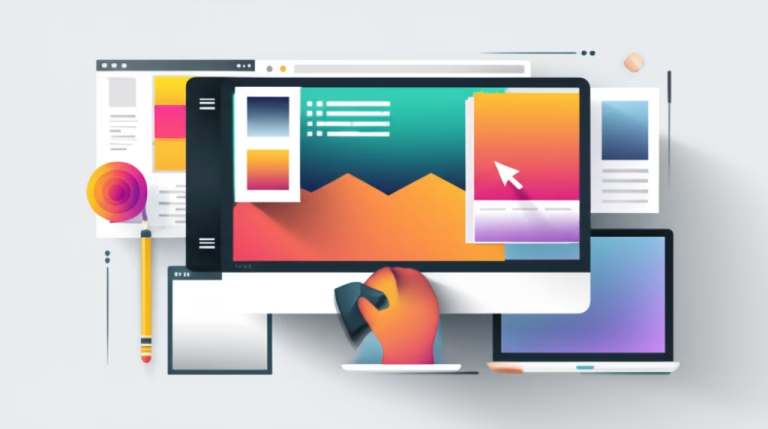Okay, aspiring designer! Ready to take that exciting step and share your creative spark with the world? Building your first design portfolio might feel like a big challenge, but think of it as your personal gallery, a place where your talent shines. It’s your chance to show potential clients or employers what you can do, even if you’re just starting out. This guide is here to walk you through creating a portfolio that truly represents you and helps you land those first amazing opportunities. Let’s get started!
Table of Contents
The Challenge Every Designer Faces
Every creative person eventually hits the same wall: how do you prove you have the skills without having worked on major projects yet? It’s a classic problem in the design world. You know you have the talent, the ideas, and the passion, but translating that potential into tangible proof for others to see can feel daunting. This is where the power of a strong design portfolio comes into play. It’s not just a collection of images; it’s your professional story, curated to make a powerful first impression and open doors to new possibilities. Without one, your amazing work remains unseen, making it hard to connect with the right opportunities and truly launch your design career.
The Science Behind Your Portfolio
Think about how people process information. We’re highly visual creatures. When someone is looking to hire a designer or commission a project, they want to see, not just read about, your capabilities. A portfolio provides that immediate visual proof. It leverages psychological principles like the primacy effect (what they see first matters) and social proof (seeing your work helps them trust your skills). It’s the most direct way to demonstrate your aesthetic, your technical abilities, and your problem-solving approach in a way words alone cannot capture. It shows you can move from concept to creation effectively.
Why does it work this way? Because design is inherently visual and experiential. You can describe a beautiful logo, but showing it allows the viewer to experience its impact, understand its context, and evaluate its effectiveness firsthand. A well-crafted portfolio creates an emotional connection and builds confidence in your abilities far more effectively than a resume or cover letter ever could. It’s a critical tool for any aspiring designer looking to stand out in a competitive field and make their mark.
Fundamental Principles
Quality Over Quantity: A common beginner mistake is thinking you need dozens of projects. It’s far better to showcase only your absolute best work, even if it’s just a few pieces. Select projects that represent the kind of work you want to do and highlight your strongest skills. Potential clients or employers don’t have endless time; they want to see your peak performance right away. Curate ruthlessly and choose pieces you are truly proud of, even if they are personal or student projects. Focus on demonstrating your understanding of design principles and your ability to execute ideas effectively.
Tailor Your Selection: Who are you trying to reach? Are you looking for freelance clients, an agency job, or maybe work in a specific niche like branding or web design? Your portfolio should be slightly adjusted depending on your audience. While a core collection is fine, consider highlighting relevant projects when applying for specific roles. Showing work that aligns with their needs makes it easier for them to envision you working on their projects. Customization shows thoughtfulness and a clear understanding of the opportunity at hand.
Make It Easy to Navigate: Your portfolio needs to be user-friendly. Potential viewers should be able to quickly understand who you are, what you do, and how to contact you. Organize your projects logically, provide clear titles and brief descriptions, and ensure your contact information is prominently displayed. A confusing or slow portfolio site can deter visitors quickly. Simplicity in navigation is key to a positive user experience, allowing your work to be the main focus without distractions or frustration.
Practical Strategies for Building Your Portfolio
- Choose Your Best Work: When to use this strategy? Always, when selecting pieces for your portfolio. How to apply? Go through all your design projects, including student work, personal projects, and any freelance gigs. Be critical and pick only the ones that best demonstrate your skills, creativity, and potential. Focus on variety if possible, but prioritize quality. If you don’t have client work yet, create some passion projects based on fictional briefs or redesigns.
- Define Your Niche (Loosely): When to use this strategy? Early on, to give your portfolio focus. How to apply? Think about what kind of design you enjoy most or want to specialize in. Do you love branding, illustration, web design, or maybe packaging? While you don’t have to strictly limit yourself, having a general focus can help attract the right kind of opportunities and make your portfolio feel more cohesive. Your selected projects should ideally reflect this interest.
- Build a Simple Website: When to use this strategy? As soon as you have a few solid projects ready. How to apply? There are many easy-to-use platforms specifically for designers (like Behance, Adobe Portfolio, or even simple website builders like Squarespace or Wix). Choose one that allows your work to be displayed cleanly and professionally without requiring coding skills. A dedicated website looks professional and gives you more control than just using social media.
- Write Clear Project Descriptions: When to use this strategy? For every project you include. How to apply? For each piece, write a brief explanation. What was the project about? What problem were you trying to solve? What was your role? What was the outcome? Explain your process a little. This context helps viewers understand your thinking and problem-solving skills, not just the final visual result. Keep it concise and easy to read.
Real Cases: When Portfolios Go Wrong
Learning from the missteps of others is a smart way to avoid making the same ones yourself. While building a portfolio is exciting, there are common pitfalls that can unfortunately hinder your progress. Being aware of these can save you time and ensure your portfolio effectively serves its purpose: showcasing your talent and attracting opportunities. Let’s look at a couple of scenarios where a portfolio doesn’t quite hit the mark and what valuable lessons we can extract from them.
Case 1: The “Everything Included” Approach
Problem: A beginner designer includes every single piece of design they’ve ever created in their portfolio, from early student exercises to unrelated personal doodles. The result is a cluttered, inconsistent collection that lacks focus and makes it difficult for viewers to discern the designer’s true strengths or preferred style. The sheer volume can be overwhelming, and weaker pieces detract from the stronger ones, diluting the overall impression of skill and professionalism. It shows a lack of curation and critical self-assessment.
Lesson: Be selective! Quality trumps quantity every single time. Curate your portfolio like a gallery owner selecting art for a prestigious exhibition. Only showcase your best, most relevant work that aligns with the type of design you want to do. Less is often more when it comes to making a powerful impact and demonstrating a clear understanding of your own capabilities and direction. This also shows respect for the viewer’s time and attention.
Case 2: Hard-to-Find Contact Information
Problem: A designer creates a beautiful portfolio website showcasing stunning work, but their contact information is buried deep within the site, requires multiple clicks to find, or is missing entirely. Potential clients or employers who are impressed by the work have no easy way to reach out and discuss opportunities. This immediately creates a barrier and can lead to lost leads and missed connections, despite the quality of the design displayed. It’s a fundamental oversight in the portfolio’s purpose.
Lesson: Make it incredibly easy for people to contact you! Your email address, a contact form, or links to professional profiles (like LinkedIn) should be immediately visible and accessible, ideally in the header, footer, or on a dedicated contact page that is clearly linked. The goal of a portfolio is to generate interest and facilitate communication, so don’t create unnecessary hurdles for those who want to connect with you about potential work or collaborations. Accessibility is key.
Your Action Plan for Your Portfolio
Building a strong design portfolio is a journey, not a race. It’s about taking consistent steps and continuously refining your presentation. Don’t feel like you need to have it all figured out or have a massive collection of work from day one. Start small, focus on progress, and build momentum. This action plan provides a simple roadmap to help you get your portfolio off the ground and moving in the right direction. Remember, every great portfolio started with a single step.
- Today: Gather all your existing design work, including school projects, personal experiments, and any small freelance tasks. Create a single folder on your computer to keep everything organized. This is the first step in assessing what you have to work with and identifying potential pieces for your portfolio. Don’t filter yet, just collect everything in one place.
- This Week: Review the work you collected. Select your top 3-5 projects that you feel are the strongest and best represent your skills and interests. Don’t worry if they aren’t perfect or client-based. The goal is to identify pieces that showcase your potential. Start thinking about *why* these pieces are strong and what they demonstrate about your abilities as a designer.
- This Month: Choose a platform to host your portfolio (Behance, Adobe Portfolio, a simple website builder). Start uploading your selected projects. Write brief, clear descriptions for each one, explaining the project’s goal and your approach. Get comfortable with the platform and how to present your work effectively. Focus on getting the basic structure and your key projects online.
- Next 3 Months: Continuously refine your portfolio. Add new, stronger projects as you create them. Seek feedback from peers or mentors and use it to improve your presentations. Actively share your portfolio link when applying for opportunities or networking. Make it a habit to update and improve your portfolio regularly as your skills grow and evolve.
Clear Your Doubts about Portfolios
It’s natural to have questions when you’re starting something new, and building a beginner design portfolio is no exception. You might wonder about the technical aspects of setting it up or how to present your work effectively when you don’t have much experience. These common questions are shared by many aspiring designers. Let’s address a couple of key doubts to help you move forward with confidence and clarity in creating your professional showcase.
Q: Do I need a fancy website to start?
A: No, you absolutely do not need a complex or expensive website initially. Platforms like Behance or Adobe Portfolio are free and designed specifically for showcasing creative work beautifully and simply.
Q: What if I don’t have any client work yet?
A: That’s perfectly normal for beginners! Showcase your best student projects, personal work, or create “spec” projects based on fictional briefs. Focus on demonstrating your skills and creative process.
The Next Step in Your Journey
Creating your first design portfolio is a significant milestone in your journey as a designer. It’s your first real step in presenting yourself professionally and opening the door to exciting opportunities. Remember that your portfolio is a living document; it will grow and evolve as you do. Keep creating, keep learning, and keep adding your best work. Your portfolio is your most powerful tool for building your design career.
Continue evolving with our guide about Design Fundamentals!



